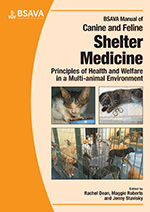
Full text loading...

This chapter starts with a discussion of the main principles underlying the quality of life and behaviour of animals in the shelter environment. The second part of the chapter focuses on specific behavioural signs, issues and problems related to housing animals within shelters. Quick reference guides: Current thinking on dog behaviour; Current thinking on cat behaviour; Socialization of puppies; Socialization of kittens; Dealing with the aggressive dog; Dealing with the hard-to-handle cat; Environmental enrichment for dogs in shelters; Environmental enrichment for cats in shelters.
Behaviour and stress management in the shelter environment, Page 1 of 1
< Previous page | Next page > /docserver/preview/fulltext/10.22233/9781910443330/9781910443330.19-1.gif

Full text loading...



















































































